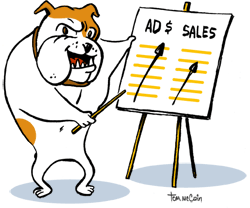 Maybe it’s time to give yourself and your team a little pep talk. Get your facts straight. Know what you’re talking about. Create a results-oriented plan that will improve sales today and better position your company for tomorrow. You can do it. What’s more, you need to do it.
Maybe it’s time to give yourself and your team a little pep talk. Get your facts straight. Know what you’re talking about. Create a results-oriented plan that will improve sales today and better position your company for tomorrow. You can do it. What’s more, you need to do it.
Going “dark” to your customers is exactly what your savvy competitors hope you will do. They recognize that there are opportunities in today’s economy. Just as importantly, they are thinking about the mid-term and long-term gains they can achieve—at your expense—by being more aggressive now.
Accountants Can Put You Out of Business.
Cutting marketing to the bone might satisfy the accounting department, but some financial people (and operations, too) often question whether marketing really sells products. A down economy is just an excuse to do what they’d like to do all of the time. It’s up to you to demonstrate that crippling marketing is a bad decision.
I’m always reminded of the story where William Wrigley is riding on a train and one of his colleagues asks him why, with a dominant market share, did he continue to promote his chewing gum so aggressively. “How fast do you think this train is going?” Wrigley asked. “I would say about 90-miles an hour,” the colleague responded. “Well then,” said Wrigley, “do you suggest we unhitch the engine?”
That’s an easier position in good times than bad, you might argue. But there is not one shred of evidence that cutting marketing during a downturn will help your organization. Consider these recession research studies:
- Yankelovich/Harris
Execs agree that seeing a company in a down market makes them feel more positive about the company and keeps them top-of-mind when making purchase decisions. - McGraw-Research Laboratory of Advertising Performance
Study of 600 BtoB marketers found that those who maintained or increased advertising during a recession averaged sales growth of 275% over the preceding five years. - American Business Press
Study revealed sales and profits could be maintained and increased in recession years and in the years following by those who maintain an aggressive posture while others become non-participants. - Harvard Business Review
Report of 200 companies found that sales increases came from companies that advertised the most during the recessionary year.
Is It Too Late?
No, but depending upon your situation, you may need to regain the confidence of executive management. And you will almost definitely need to be creative with your budget and reallocate money to areas that will generate the most measurable results. You should focus on:
- Adding Value. The last thing you want to do is engage in discount battles—especially with your top brands. Price cuts not only hurt current profitability, but they also can be difficult to escape later. A low price tends to become the expected price. Demonstrate instead that you identify with your customer’s challenges and build on values such as durability, security, ease-of-use and timesavings.
- Selling More to Existing Customers. Returns are so much better and less expensive than prospecting. Increasing your share of customer through more frequent and/or larger purchases can do wonders for your bottom line.
- Improving Data Mining. Whether you are selling to existing customers or prospecting, nothing will increase results more that instituting database marketing best practices. Get your data out of departmental silos and into a centralized database that offers a single view of each customer. Then you can begin adding sophistication through data appending, predictive modeling and many other techniques often overlooked or underutilized by even large companies.
- Adding Marketing Automation. You can streamline your marketing program and improve results through marketing automation systems. Good ones will not only help you efficiently manage and execute campaigns, but will also provide the valuable reporting you need. With a recent CMO study indicating that 20 percent of executive-level marketers don’t track their marketing returns at all, there is plenty of room for improvement.
- Integrating Multiple Channels. Anyone who is paying attention knows that the best returns come from campaigns that skillfully integrate multiple channels. Just make sure you commit your limited funds to the right channels. Consider what Gregg Ambach of Analytic Partners said in an article that appeared in the July 2009 issue of Deliver magazine: “(Digital) is incredibly efficient, because the cost per thousand is low. But it’s just not moving a lot of volume yet.” So be careful about being penny wise and pound foolish when allocating recession marketing dollars.
By Larry Bauer
Want Expert Advice?
MondoVox Creative Group can help you develop cost-effective, multi-channel marketing campaigns—from strategy through execution—that deliver measurable results. For more information, email Julia Moran Martz.
You can connect with Julia Moran Martz on LinkedIn. Or follow her on Twitter.









